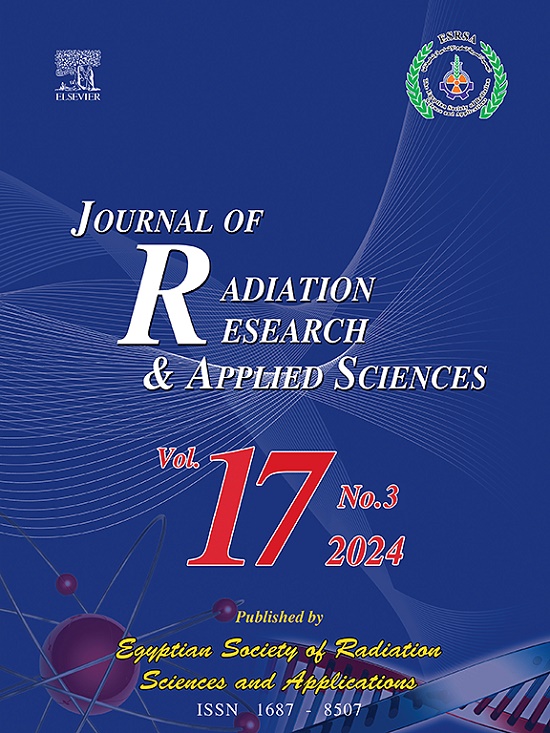Detection and classification on MRI images of brain tumor using YOLO NAS deep learning model
IF 1.7
4区 综合性期刊
Q2 MULTIDISCIPLINARY SCIENCES
Journal of Radiation Research and Applied Sciences
Pub Date : 2024-10-08
DOI:10.1016/j.jrras.2024.101113
引用次数: 0
Abstract
If a brain tumor is not properly diagnosed, it might result in fatal consequences and major health issues. As a result, a key component of diagnosis is the early identification of brain tumors and the precise categorization of brain tumor types. This research work focusses on detection and classification such as pituitary, meningioma, glioma, and non-tumorous tumors from brain tumor MRI image using YOLO NAS model. Advances in deep learning have led to an increasing awareness of computer-aided diagnosis technology. To improve classification performance, the input data set is acquired from the REMBRANDT repository using the Digital Database of Brain Tumor Magnetic Resonance Images. The primary phases of this task include segmentation, classification, and pre-processing. The researcher preprocessed the RGB image to exclude any undesired spots before locating the ROI. For each brain tumor image, we used the hybrid anisotropic diffusion filtering (HADF) technique to remove noise. The Encoder-Decoder Network (En–DeNet), which uses a deep neural network based on U-Net as the encoder and a pre-trained EfficientNet as the decoder, is then used to segment the MRI images. A proposed model was developed using a deep learning-based YOLO NAS technique to identify brain cancers from MRI images such as meningioma tumors, non-tumor, glioma tumors, and pituitary tumors. The suggested model's classification performance is weighed based on parameters such as precision, F1-score, sensitivity, accuracy, and specificity. The proposed fusion method YOLO NAS has improved classification results of accuracy (AC = 0.997%), specificity (SP = 0.985%), precision (PR = 0.982%), F1-score (F1 = 0.992%), and sensitivity (SE = 0.985%) using 2570 MRI data for training and 630 data for testing and validation of brain tumor cases. The results show that the brain tumor type classification system based on the proposed YOLO NAS technique works better than the DNN, PDCNN, DenseNet-161, and DCNN-SGD model classifiers.
使用 YOLO NAS 深度学习模型对脑肿瘤 MRI 图像进行检测和分类
如果脑肿瘤得不到正确诊断,可能会导致致命后果和重大健康问题。因此,诊断的一个关键环节是早期识别脑肿瘤,并对脑肿瘤类型进行精确分类。这项研究工作的重点是利用 YOLO NAS 模型从脑肿瘤 MRI 图像中检测和分类垂体瘤、脑膜瘤、胶质瘤和非肿瘤。深度学习的进步使人们对计算机辅助诊断技术的认识不断提高。为了提高分类性能,输入数据集是利用脑肿瘤磁共振图像数字数据库从 REMBRANDT 数据库中获取的。这项任务的主要阶段包括分割、分类和预处理。研究人员对 RGB 图像进行预处理,以排除任何不需要的斑点,然后再定位 ROI。对于每张脑肿瘤图像,我们都使用了混合各向异性扩散滤波(HADF)技术来去除噪声。编码器-解码器网络(En-DeNet)使用基于 U-Net 的深度神经网络作为编码器,并使用预先训练好的 EfficientNet 作为解码器,然后用于分割 MRI 图像。利用基于深度学习的 YOLO NAS 技术开发了一个拟议模型,用于从磁共振成像图像中识别脑膜瘤肿瘤、非肿瘤、胶质瘤肿瘤和垂体瘤等脑癌。建议模型的分类性能根据精确度、F1-分数、灵敏度、准确度和特异性等参数进行权衡。使用 2570 个 MRI 数据进行脑肿瘤病例的训练,并使用 630 个数据进行测试和验证,所提出的融合方法 YOLO NAS 在准确性(AC = 0.997%)、特异性(SP = 0.985%)、精确性(PR = 0.982%)、F1 分数(F1 = 0.992%)和灵敏度(SE = 0.985%)方面的分类结果均有所改善。结果表明,基于 YOLO NAS 技术的脑肿瘤类型分类系统优于 DNN、PDCNN、DenseNet-161 和 DCNN-SGD 模型分类器。
本文章由计算机程序翻译,如有差异,请以英文原文为准。
求助全文
约1分钟内获得全文
求助全文
来源期刊

Journal of Radiation Research and Applied Sciences
MULTIDISCIPLINARY SCIENCES-
自引率
5.90%
发文量
130
审稿时长
16 weeks
期刊介绍:
Journal of Radiation Research and Applied Sciences provides a high quality medium for the publication of substantial, original and scientific and technological papers on the development and applications of nuclear, radiation and isotopes in biology, medicine, drugs, biochemistry, microbiology, agriculture, entomology, food technology, chemistry, physics, solid states, engineering, environmental and applied sciences.
 求助内容:
求助内容: 应助结果提醒方式:
应助结果提醒方式:


